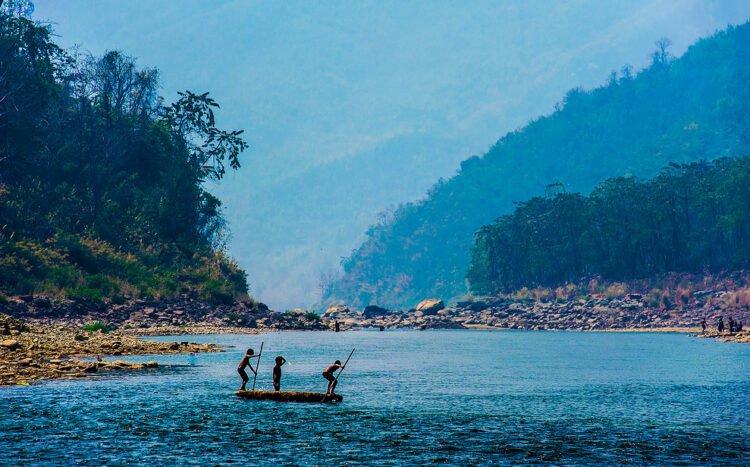No products in the cart.
Incredible Mizoram with rich culture & Traditions of Rising India
Always close to nature in these breezy, salubrious hills, the Mizos are gregarious, simple, friendly and peace-loving people
The state of Mizoram is bound by Assam and Manipur in the north, Myanmar in the east and south and Tripura and Bangladesh in the west. With 87% literacy, second largest in India it is a dazzling mix of cross-cultural vibrancy. In February 1972, it became the 23 state of the Indian Union. It is one of the most sparsely populated states in India. The state capital is surrounded on the east by Tuiral River, in the north by the Durrlang hills and on the west by the Tlawng River. Aizawl is situated at an altitude of 1132 m above sea level. This 112 year old city stands on the ridges of steep hills. The city is connected with Guwahati, Kolkata and Imphal by Air India and the nearest airport is at Lengpui, 43 km from Aizawl. The nearest railhead is Silchar in Assam, 180 km away. However, Guwahati Railway Station is highly recommended as it is well connected by train with all major cities/towns of the country. From Guwahati, tourists can travel by bus/sumo Jeeps via Shillong and Silchar. Foreign Tourists earlier needed Restricted Area Permit to visit Mizoram, which has been lifted initially for 1 year from January, 2011 onwards.
Culture
Always close to nature in these breezy, salubrious hills, the Mizos are gregarious, simple, friendly and peace-loving people. Since the days of the chieftains they have always been a close-knit society with moral values based on Tlawmngaihna, or essentially, selfless service for others, a rare principle which goes well with Christianity. The Mizo chiefs too, who were abolished in 1952, had never ruled supreme, always making decisions in consultation with the village elders, and sometimes, even their citizens on crucial issues. Today there is practically no status or class distinction amongst the members of the society who all rank equal, enabling even a fourth-grade employee of the government to chair a social gathering or a church service attended by officers of high ranks, the privilege being accorded to any active volunteer or worker. Moreover, the local communities, now largely represented by the Young Mizo Association, voluntarily assume the responsibility of helping the needy and the poor. The Mizos are proud to say that hardly any beggar is to be found in the streets.
FESTIVALS

Traditional festivals of Mizoram are full of splendid gaiety and are a great insight to the rich cultural heritage of the Mizos. The festivals are celebrated with pomp and fervor and traditional dances form a major part of the celebrations. Since agriculture plays a significant role in the lives of people, almost all the festivals of Mizoram are centered on agricultural activities: the sowing, the harvesting, the seasonal cycles etc. The Major festivals of Mizoram are:
Chapchar kut-Chapchar Kut festival of Mizoram is a spring festival and marks the preparation before the onset of the sowing season. This is the only festival among all the traditional festivals that it still celebrated with the initiative of the Mizoram Government. This is the
time when jungles are cleared, bamboos and trees are dried and kept for burning, and the land is set ready for jhum cultivation.

Winter Festival of Mizoram
Winter Festival is an annual three day festival organized by Department of Tourism, Government of Mizoram in association with other departments. Winter Festival was previously called Thalfavang Kut. The venue for the festival is set at Tuirial Airfield, an abandoned airstrip 21 kms from the city centre. It is celebrated to showcase the diverse culture and traditions of the Mizos with a host of entertainment. The origin of Thalfavang kut reflects the close knit society and deep camaraderie that knit the Mizos together wherever they are. Insurgency in the 1960’s and 70’s in Mizoram dislocated families from their homes, villages and towns. It disrupted education and students had to flee to the neighboring states to continue their studies. Having to adjust to cultures completely different, haunted by tragedies back home and visions of lush green hills of their homeland taunted them. Thus, these students gave birth to Thalfavang kut. An annual festival held in their various places of study. They would get together, perform traditional dances, sing folk Songs, share their experiences, encourage each other and at the end of the day share a feast.
Christmas Celebration
It is regarded as one of the biggest celebration of the place. Held from the 24h to 26th of December, Christmas is celebrated in Mizoram for three whole days. Since the majority of Mizoram population belongs to the Christian faith, Christmas festival is celebrated throughout the State with much fanfare. People gather in churches to worship and share a grand feast.
Christmas in Mizoram is an ideal manifestation of the rich heritage of the Christian faith in the place
English Calendar New Year Celebration in Mizoram
The whole of Mizoram celebrates New Year with great splendour. Like most part of the world, fireworks and crackers used to be a part and parcel of this celebration. A complete change took place in 2009 when the government of Mizoram announced a complete ban on fireworks and crackers. The prohibition has been a complete success since then and now virtually not a sound of crackers nor fireworks can be heard during the time of the year. Since majority of the population are Christian, most local churches organize mid-night service. Concerts, carols and street shows are organized at different places.
Top singers and musicians participate in these concerts to entertain the people. On New Year’s Day, all local churches organize community feasts in their respective localities. Every community member participates in the preparation of such grand feast to later enjoy it together. All big shops, government offices and markets remain closed on this day while the streets are devoid of vehicles.
CULTURE AND MODERN DAY PRACTICES

Mizoram runs on its own rhythm. Most businesses open early and shut by 6 pm; virtually everything closes tight on Sunday. The culture of the Mizo tribes and its social structure has undergone tremendous change over 100 years, since the arrival of Christianity in late 1890s. Contemporary people of Mizoram celebrate Christmas, Easter and other Christian celebration replacing many of the old tribal customs and practices.
In modern Mizoram, much of the social life often revolves around church. Community establishment exist in urban centres that arrange various social events, sports events, musical concerts, comedy shows and such activities.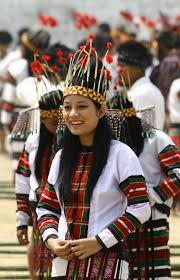
The Mizo people take pride in their cultural diversity even though Mizoram is moving towards modernization but the state government has ensured that every bucolic hamlet in the state, irrespective of its remote location, is endowed with an NGO called YMA (Young Mizo Association). The people belonging to the YMA take care in maintaining the traditional values and customs to be followed and kept alive by the upcoming generations.
Places to visit
Pala Tipao (Palak Dil)
Pala Tipao or Palak Dil is the largest natural lake in Mizoram and it is situated near Phura, about 65 km to the south of Lawngtlai. Oval in shape, it covers about 1 sq km and is surrounded by lush virgin forests rich in flora and fauna. Legends abound about the origin of the lake. One version says that before the lake was formed, there used to be a big village here and a large serpent lived in a cavern in the vicinity and occasionally stole the villagers’ livestock. When it started stealing their children, the men gathered in anger and made a plan to kill the large snake. Using a huge fish hook and a dead goat for bait, they soon managed to catch and kill the serpent and then distributed its meat to every household for dinner. That night strange things began to happen. A widow living with her two children got the serpent’s head as her share and started cooking it in a big pot. After sometime she looked into the boiling pot to find the eyes of the serpent blinking, rolling and watching her. Frightened out of her wits, she flung the pot away with the serpents head still inside it. Later, she heard strange noises and ran out of the house to find her doorsteps being flooded with water which continued to rise rapidly. She took her children and ran away just before the water submerged the whole village, drowned all the other inhabitants who were sleeping and formed a wide lake that has come to be called Pala Tipao or Palak Dil, meaning “a lake that has taken away many men”.
Phawngpui Mountain
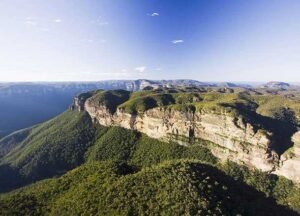
The highest mountain in Mizoram, Phawngpui or the Blue Mountain is situated near the state’s south-eastern border, about 85 km from Hnahthail, overlooking the bend of the mighty Chhimtuipui river and hill range of Myanmar. The ridge stretches nearly 10km in north-south direction and reaches a height of 2157 m at the peak near the southern end. It is surrounded by sheer precipices of which Thlazuang Kham is the most spectacular one.
Abounding with diverse flora and fauna, Phawngpui has been declared a National Park covering an area of about 50 sq km. The thick forest are interspersed with small patches of grassy glades and are replete with diverse fauna typical of Montane Sub-tropical forests including oak, rhododendrons and rare species of orchids and bamboos.
With the cliffs and rocky ledges on all sides providing natural shelter, Phawngpui is home to a variety of endangered mammals like the Slow Loris, Tiger, leopard, Leopard cat, Serow (the state animal), Goral, Asiatic Bear, Stump-tailed Macaque and Capped Langur and an amazing variety of birdlife including the rare Blyth’s Tragopan, Dark Rumped Swift, and Mrs. Hume’s Pheasant, the Mizoram state bird. As a National Park, entry is being regulated by the Environment & Forest Department of Mizoram.
Castle of Beino
The Western Region of Saiha in the Southern part of Mizoram boasts of a mesmerizing rock formation that resembles a castle. It is known for its geographical marvel which is a craftsmanship of nature.
Champhai
Champhai is a commercial town located near the Myanmar border, 194 km from Aizawl. Set on an altitude of 1678m, the town overlooks a patch of flat land which happens to be the largest plain area in the state and also commands a good view of the adjoining hill ranges of Myanmar from which the forefathers of the Mizos immigrated ages ago. The breezy hills around here are lush and strewn with beautiful rhododendron blossoms. Within a few kilometers away are some villages of historical significance where the age-old Mizo way of life is still preserved.
The town is 27 km from Zokhawthar, the border township through which the Indo-Myanmar trade is being conducted and hence, Champhai is an ideal shopping place for various imported goods. The town is also a convenient base for trekking and visiting landmarks and historical places in the vicinity including Rih Dil, the mythical lake located 5km within Myanmar which is associated with the Mizo animist religion of yore.
Kawtchhuah Ropui
In the vicinity of Vangchhia, close to the Myanmar border, about 50km to the south of Champhai, there are a large number of menhir stones erected on the sides of the road in a series of line called Kawtchhuah Ropui or “the great entranceway”. In the olden days, similar commemoration stones or Lungdawh usually marked the entrance to a Mizo village. Varying in sizes and shapes they number 171 in all and bear embossed carving of figures of human beings and animals. There is a striking resemblance between the relief carvings on these stones and those on Mangkhaia Lung and some other stones in the state. The village was named after the Vangchhia clan who were known as the earliest settlers here and these stones are attributed to them.

Reiek Tourist Resort
To the west of Aizawl, only 35 km away is a large mountain on which Reiek village is located. A destination that should not be missed, Reiek Mountain, with spectacular rocky cliffs on the southern and western sides, is still largely covered with luxuriant natural forests preserved since the days of Mizo chiefs. It is only an hour’s drive from Aizawl and before reaching Reiek,
A typical Mizo village consisting of the distinctive traditional huts of the different Mizo sub-tribes has been created and is maintained by the Department of Tourism. The houses are fully furnished giving the visitors a peek into the glorious past of the valiant highlanders. A few Mizo modern houses have also been constructed nearby to show the changes that have taken place in the Mizo way of life in keeping pace with the modern development. Here the department runs a cafeteria and a resort providing decent food and accommodation. This is also the venue for the annual Anthurium Festival.
The thick forests in the hills are home to a fantastic variety of hill birds, including the rare Peregrine falcon which one might see perched on a lofty ledge or swooping on cliff swallows. A cobbled trekking trail leads right to the top of the peak where there is a big boulder jutting out over a high precipice. Folklore goes that this is where Ngaitei, a poor orphan girl, used to sit to watch the swelling Tlawng River that swept away her father, whose sprit continued to live under the water and later threatened to flood Ngaitei’s village unless they throw her into the water so that they would be reunited. A beautiful panorama of hills spreads out from the viewing tower at the airy glade on the top.

Hmuifang Tourist Resort
Hmuifang Tourist Resort is an ideal gateway located at the scenic peak of Hmuifang mountain, 50 km to the south of Aizawl. With an elevation of 1619 meters, the mountain is still covered with virgin forests reserved since the days of the Sailo chiefs. The patches of grassy glades on the peak are also suitable for picnic and outdoor camping in the midst of nature. Built right on the former land of Lallianvunga, the erstwhile chief who used to rule over the village of Himuifang around the late eighteenth century, the resort has comfortable accommodation and a lovely cafeteria. From here one may visit the four Mizo villages situated on the hillsides, Hrouifang, Sumsuih, Lamchhip and Chamring to see the typical rural life of the Mizos. The mountain also has spectacular cliffs and offers great views of the surroundings hills. Again, to the nature lovers, the forests abound with fascinating varieties of flora including rare orchids and wildlife especially avifauna.
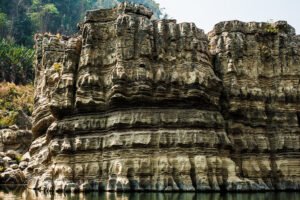
During the days of chief Lallianvunga, the extremely cold climate of the mountain top was suspected to cause low fertility amongst the women folk and the village was moved to a different location after a few years. Soon after setting up a permanent post in Mizoram which was then known as the Lushai Hills, the British cut a bridle path through the rocky hillside with great difficulty in 1900, linking the northern and the southern hills and also made use of the vantage point on the peak summit for a heliograph signal post, which proved to be of great strategical use during the Second World War when the invading Japanese army posed a threat to the Indian frontiers. The government also experimented with potato cultivation with a few selected families in 1906 here with great success and to this day it has been a means of livelihood for many of the villagers on this mountain.
Vantawng Khawhthla (Vantawng Falls)
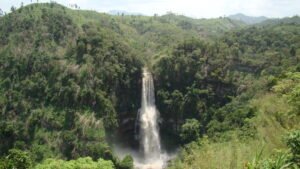
Of all the waterfalls and cascades in the rough and fast-flowing rivers of Mizoram, Vantawng Khawhthla or “Vantawng Falls” is the highest and the most spectacular one. Located in Vanva river near Thenzawl, 93 km to the south of Aizawl, it is named after Vantawnga who was said to be an excellent swimmer. So good a swimmer was Vantawnga, so the story goes, that he could hover in the cascading water as some fish do, but unfortunately during one of such performances, a drifting log fell from above and killed him. The height of the fall is recorded as 750ft and though it is difficult to get close to it because of the sheer forested hillsides surrounding it, a comfortable viewing tower has been constructed by the Tourism Department.
World’s Largest family, Baktawng
Recorded in the Guinness Book of World Records as the World’s Largest Family. The joint family is headed by Pu Ziona, who has 38 wives, 89 children and a large number of grandchildren. A total of 162 members of the family live in a four-storey building called “Chhuanthar Run’ or home of the New Generation in Baktawng
village, 70 kms from Aizwal. Living as a religious community, the family owns jhums, orchards, furniture workshops, manufactures aluminium utensils and are known for their self-sufficiency, craftsmanship, hard work
and entrepreneurship skills. Originally known as “Khuabgtuaha Pawl’, a breakaway group of the Presbyterian Church, the religious sect came into being on June 12, 1942 after Khuangtuaha, the founder was evicted from Hmawngkawn village by the village chief. Christian missionaries at that time felt that the theology of Khuangtuaha who believed in the use of drums as an instrument of worship was too liberal and dangerous. After the death of Khuangtuaha they renamed themselves ‘Chana Pawl’. They still observe June 12 every year as ‘Bawkte Kut’ or ‘Festival of the Hut’ to commemorate the eviction and birth of the sect.
Mr. Chana, who inherited the baton from his late brother Khuangtuaha believed in Polygamy and that God permitted him to marry as many wives as he could feed. After Chana died on 27 February, 1997, the leadership of the sect was taken over by his eldest son Ziona, who reportedly has more wives than his father.
The members of this religious community do not mind being called a religious sect because they take pride in nurturing the legacy of ‘Lalpa Kohhran’ (The Lord’s Church) founded by their godfather Chana in 1996. The administration of the religious community is so complete that besides the religious aspect of the unit, the ‘Lalpa Kohhran family’ has their own school called Chhuanthar Students Home (Class V to Class X) and a playground they call Chhuanthur stadium.

Their way of life can be experienced by staying with them at their guest house in Baktawng village.
The Legends of the Caves
For the lovers of nature and adventure, Mizoram has quite a number of caves and caverns, or puk in Mizo, most of which are associated with legends and folklores.
Khuangchera Puk
In Ailawng near Reiek, about 30 kms from Aizawl in the west, there is a cave named after Khuangchera, the legendary Mizo warrior who lived here in the late nineteenth century. The story goes that in Khuangchera’s days the villagers got water from a spring flowing out of a narrow cave which everyone feared to enter out of superstition. A debate went on whether another cave up on the other side of the hill was connected with it since water was seen flowing in there without any visible outlet elsewhere in the vicinity, but no man had the courage to prove it. Finally, Khuangchera decided to get to the bottom of it. Using a large torch of split bamboos, he went inside the cave and after some time emerged from the other end, and so proved for once and for all that the two cave mouths joined a single underground passage through the hill. However, he was said to be struck down by a serious illness for some days soon after this, which only served to aggravate the villager’s fear of the cave. After this, it was only in the early eighties that a full exploration of the cave was made by a local adventure club.

Lamsial Puk
Situated near Farkawn village on a rockface, this cave contains a number of human skulls and bones as well as pieces of some traditional shawls with which they had been possibly wrapped. While the bones are estimated to be about three hundred years old, no precise explanation has yet been found as to the identities of the people and when and why they were placed here. However, it has been commonly assumed that they were left there by the people of the erstwhile Lamsial Village which used to be located around here when the Mizos began to settle down in this area after crossing the Tiau River bordering Myanmar.
Pukzing Puk
Situated at Pukzing village area near Marpara in western Mizoram, this is perhaps the biggest cave in the state with a width of about 300 ft, a height of about 150 ft and depth of about 100 ft. The story goes that it was carved out of the hillside by the legendary strong man Mualzavata by using only his hair pin. It is also said that another mythical figure Maurawkela hid the magical drum he took away from a troop of monkeys after seeing them conjure fruits by beating it.
Tilpari Puk
Named after Tialpari, daughter of Cheural chief, this cave is situated on the southern side of Phawngpui Mountain. A small but cozy cave, it is associated with the touching story of Tialpari who ran away and took shelter here when her parents tried to force her to marry a chief of a far castere village. It is said that during her hiding her fither send search parties, and a few of them did find her out, bur never reported to her father, instead they secretly gave her their packed food because they took pity on her as they all knew she was in love with a strong and brave warrior named Dopra happened to be away at that time. It is said that at night a tiger used to come to keep her company and she would cuddle up against it for warmth. She remained here for many days until Dopawrhs became chief of a village called Mampui and the couple Irved happily afterwards.
Rulchawm Kua
In Rulchawm village about 40km from Aizawl to the east there is “the cave where sacrifices were made to a serpent”. Although not much remains of the cave which is said to be huge and extremely long in the olden days, it is particularly noteworthy as snake worship was rare even in animistic days of the Mizos. Legends has it that once a large serpent lived in this cave, always coiling up near the entrance and demanding sacrifice of one human being for its food every day from the nearby villagers who lived in great fear for many days. Their fear was exacerbated by deep sadness one day when it was the turn of the beautiful daughter of the chief to be sacrificed. However, a brave young man came to the village that day, offered to kill the serpent if he would be given the hand of the princess in marriage. The chief and the villagers readily agreed. Thus, the young man wrapped goat’s meat and offal around a very sharp sword, then bound this with rags to make it look like a human figure and offered it to the serpent. The unsuspecting serpent swallowed the bait and was pierced to death by the sword hidden inside. And so the young man saved the villages and married the beautiful princess. The jubilant villagers made a feast of the dead snake and celebrated for many days.
Skilled Craftsmen
The Mizo men excel in handicrafts especially those of cane and bamboo, having practically transformed them into works of art from mere functional pieces. They are known for their weaving skills of various traditional baskets for different uses and purposes. For example, Piakawng, which is used generally for carrying grains and similar items, is meticulously woven in complex pattern and can yet hold surprisingly great weights. The Mizo cap, Khumbeu is an excellent piece of bamboo-craft that makes good souvenir for visitors.
For anyone looking for a souvenir, a good selection of various traditional handicrafts and handloom products are available in Aizawl at Hnamchhantu located in Republic Veng, Ethnic Warehouse at Zarkawt and in some shops in the local market.
ENTERING MIZORAM
Castle of Beino
Visitors to Mizoram are required to obtain an ‘inner line permit’ before entering the State. Domestic and international visitors face different requirements.
Domestic Tourists
Domestic tourists require Inner line Pass / Permit that can be obtained from the Liaison Officer, Government of Mizoram in Kolkata, Silchar, Guwahati and New Delhi. Those arriving by air can obtain a 15 day visit pass on arrival at Lengpui airport, Aizawl by submitting photographs and paying the fees of Rs.120. A valid identity proof is required to obtain the pass. Visitors arriving by road from Assam can also get an inner line permit at the check gate on arrival of Vairengte.
International Tourists
Foreign nationals have to register themselves at the Foreigner’s Registration Office, CID within 24 hours of arrival, a formality that is compulsory. Citizens of Afghanistan, China and Pakistan and foreign nationals having their origin in these countries are required to get a pass through the Indian consulate or from the Ministry of Home Affairs in New Delhi, before they arrive in Mizoram.
Best time to travel Mizoram from October to May.
How To Reach
By Air :There are daily flights operated by Air India and Indigo to Aizawl from Delhi, Kolkata and Guwahati and once a week Air India connects Kolkata via Imphal. The airport at Lengpui is about 32 km from Aizawl. Taxi services can be hired at the airport to get to Aizawl.
By Road : There are share cabs service plying separately between Aizwal to Guwahati, Shillong and Silchar. One can also rent a private car from Assam, Meghalaya and other neighbouring states to get to Mizoram. The main entry point is at Vairengte for travellers entering from Assam and Meghalaya where one can get a temporary Inner Line Permit Issued at the check gate.
By Train : The nearest railhead is at Bairabi in Kolasib District about 117 Kms from Aizawl. But it is however advisable to take train that stops at Silchar in Assam as the road condition are more favourable. For further information please visit: www.mizotourism.nic.in or contact tour operators: Quality Tours & Travels,


